sensor AUDI A5 COUPE 2012 Owner's Guide
[x] Cancel search | Manufacturer: AUDI, Model Year: 2012, Model line: A5 COUPE, Model: AUDI A5 COUPE 2012Pages: 316, PDF Size: 78.59 MB
Page 179 of 316
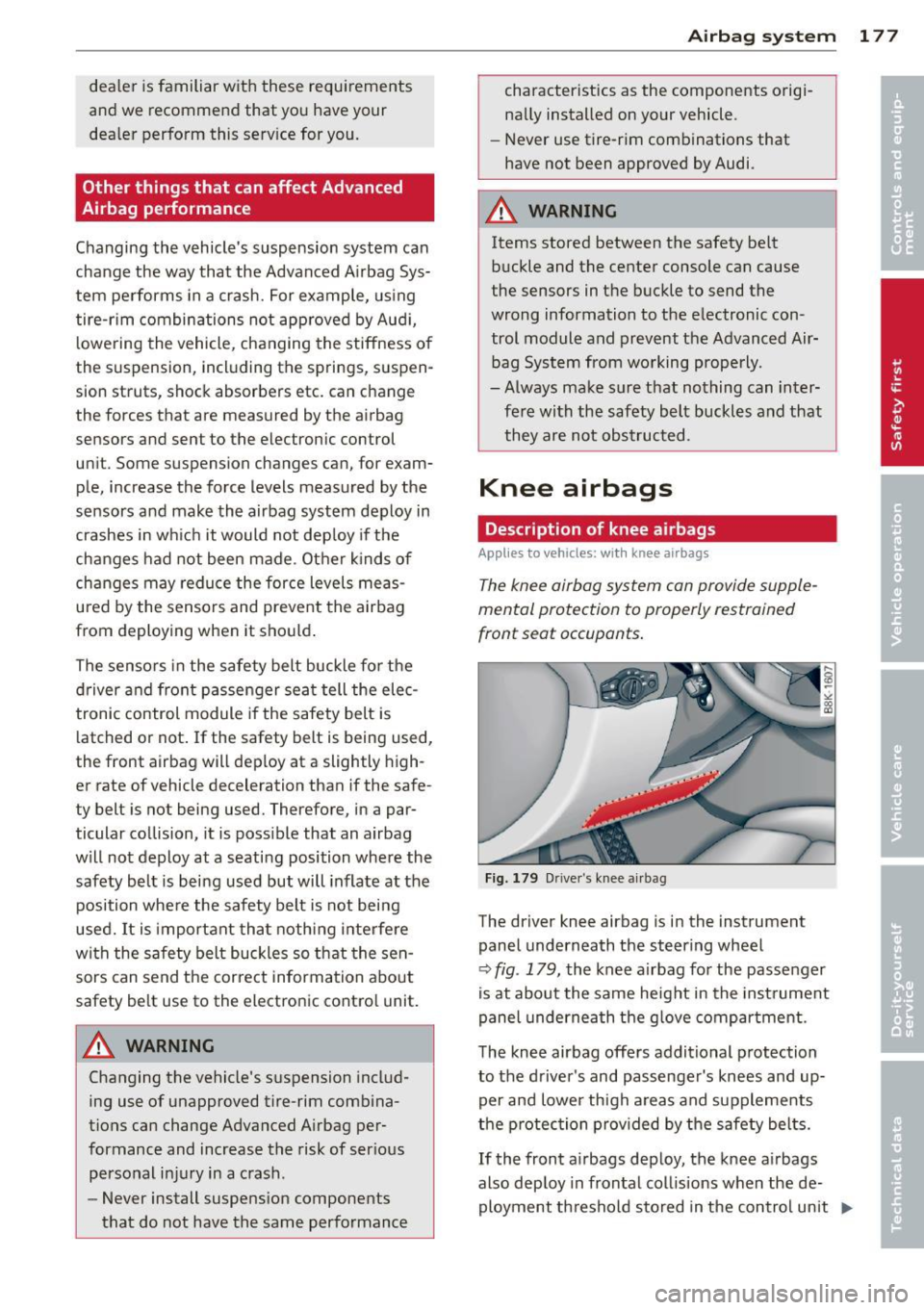
dealer is familiar with these requirements
and we recommend that you have your
dealer perform this service for you.
Other things that can affect Advanced
Airbag performance
Changing the vehicle's suspension system can
change the way that the Advanced Airbag Sys
tem performs in a crash. For example, using
tire-r im combinations not approved by Audi,
lowering the vehicle, changing the stiffness of
the suspension, including the springs, suspen
sion struts, shock absorbers etc. can change
the forces that are measured by the airbag sensors and sent to the electronic control
unit. Some suspension changes can, for exam
ple, increase the force levels measured by the
sensors and make the airbag system deploy in
crashes in which it would not deploy if the
changes had not been made . Other kinds of
changes may reduce the force levels meas
ured by the sensors and prevent the airbag
from deploying when it should .
The sensors in the safety belt buckle for the
d river and front passenger seat tell the elec
tronic control module if the safety belt is
latched or not. If the safety belt is being used,
the front airbag will deploy at a slightly high
er rate of vehicle deceleration than if the safe
ty belt is not being used. Therefore, in a par
ticular collision, it is possible that an airbag
will not deploy at a seating position where the safety belt is being used but will inflate at the
position where the safety belt is not being
used. It is important that nothing interfere
with the safety belt buckles so that the sen
sors can send the correct information about
safety belt use to the electronic control unit.
.&_ WARNING
Changing the vehicle 's suspension includ
ing use of unapproved tire-rim combina
tions can change Advanced Airbag per
formance and increase the risk of serious personal injury in a crash.
- Never install suspension components
that do not have the same performance
Airbag system 177
characteristics as the components origi
nally installed on your vehicle .
- Never use tire-rim combinations that
have not been approved by Audi.
.&_ WARNING
= -
Items stored between the safety belt buckle and the center console can cause
the sensors in the buckle to send the
wrong information to the electronic con
trol module and prevent the Advanced Air bag System from working properly.
-Always make sure that nothing can inter-
fere with the safety belt buckles and that
they are not obstructed.
Knee airbags
Description of knee airbags
Applies to vehicles: wit h knee airbags
The knee airbag system can provide supple
mental protection to properly restrained
front seat occupants.
Fig. 179 Driver 's knee airbag
The driver knee airbag is in the instrument
panel underneath the steering wheel
Q fig . 179, the knee airbag for the passenger
is at about the same height in the instrument
panel underneath the glove compartment .
The knee airbag offers additional protection
to the driver's and passenger's knees and up
per and lower thigh areas and supplements
the protection provided by the safety belts.
If the front airbags deploy, the knee airbags
also deploy in frontal collisions when the de ployment threshold stored in the control unit
I),-
Page 182 of 316
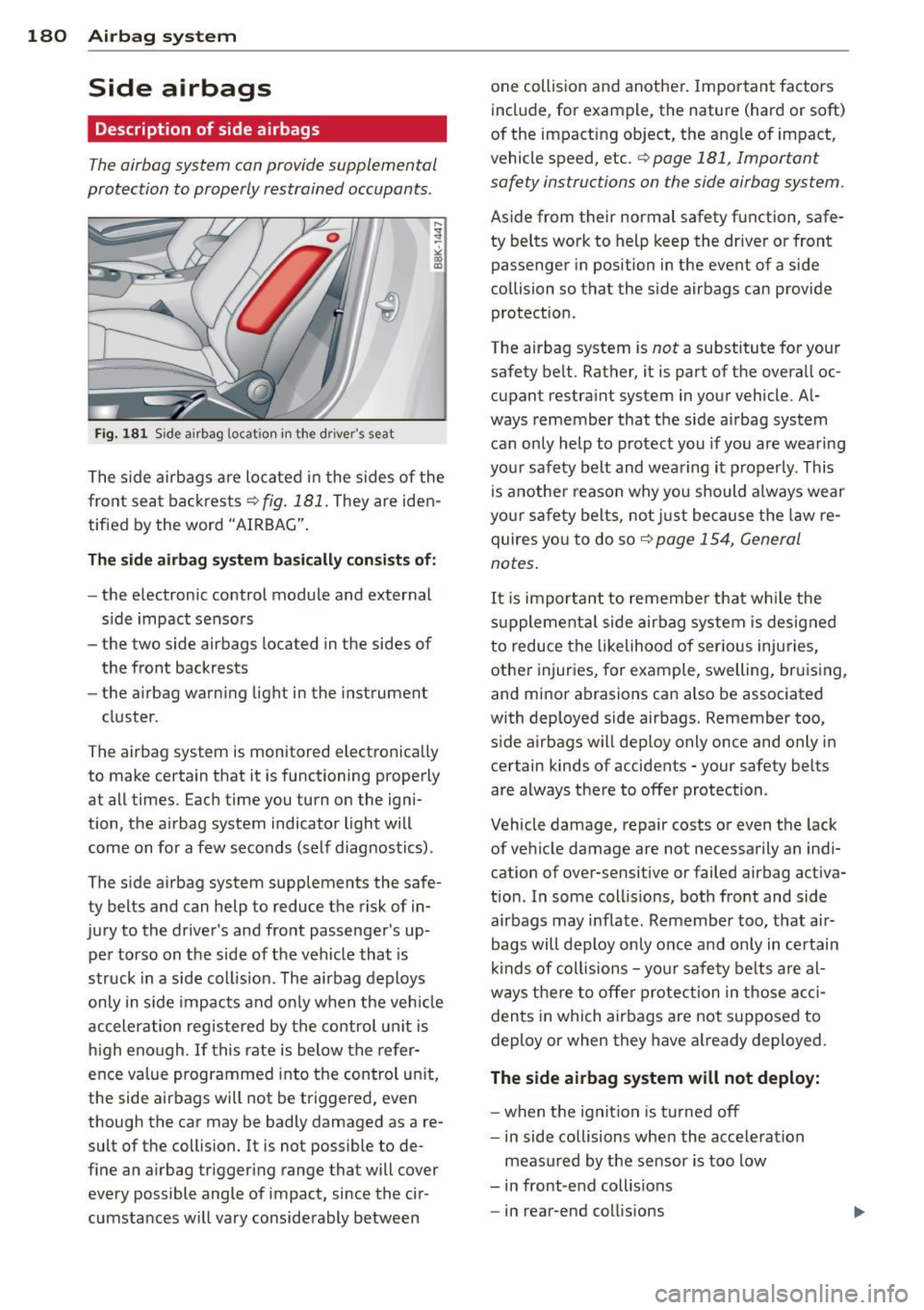
180 Airbag system
Side airbags
Description of side airbags
The airbag system can provide supplemental
protection to properly restrained occupants .
Fig. 18 1 Side a irbag locat io n in the d river 's seat
The s ide airbags are located in the sides of the
front sea t bac krests
~ fig. 181. They are iden
tified by the word "AIRBAG" .
The sid e airbag system basicall y consis ts of :
-the electronic control module and external
side impact sensors
- the two side airbags located in the sides of
t h e front backrests
- the a irbag warn ing light in the instrument
cluster.
The airbag system is monitored electronica lly
to make certain that it is functioning properly at all times. Each time you turn on the igni
tion, the airbag system indicator light will
come on for a few seconds (self diagnostics) .
The s ide airbag system supplements the safe
ty belts and can help to reduce the risk of in
jury to the drive r's and front passenger's up
pe r torso on the side of the vehicle that is
struck in a side col lision . The airbag deploys
on ly in side impacts and on ly when the veh icle
acceleration registered by the control unit is h igh eno ugh . If this rate is below the refer
ence va lue programmed into the control un it,
the side airbags will not be triggered,
even
though the car may be badly damaged as a re
sult of the collision. It is not possible to de
f ine an a irbag tr igger ing range that will
cover
every
possible angle of impact, since the cir
cumstances w ill
vary considerably between one collision and another.
Important factors
incl ude, for example, the nature (hard or soft)
of the impacting object, the angle of impact,
vehicle speed, etc .
c:> page 181, Important
safety instructions on the side airbag system .
Aside from their normal safety function, safe
ty belts work to help keep the driver or front
passenger in position in the event of a side
collision so that the side airbags can provide
protection .
The airbag system is
not a substitute for your
safety belt . Rather, it is part of the overa ll oc
cupant restra int system in your vehicle . Al
ways remember that the side airbag system
can only help to protect you if you are wea ring
you r safety belt and wea ring it p roperly . This
is anothe r reason why yo u should always wear
yo ur s afe ty be lts, no t ju st because the law re
quires yo u to do so~
page 154, General
notes .
It is impo rtant to remembe r th at w hile the
s u pplementa l side airbag system is designed
to reduce the likelihood of ser io us inju ries,
othe r injuries, for example, swelling, br uising ,
and minor abrasions ca n also be associated
with deployed side airbags. Remember too,
s ide airbags will deploy only once and only in
certain kinds of accidents -your safety belts
are always there to offer protection .
Vehicle damage, repair costs or even the lack
of ve hicle damage are not necessarily an ind i
cation of over-sensitive or failed airbag activa
t io n. In some coll is ions, both front and side
airbags may inflate . Remembe r too, t hat air
bags will deploy only once and on ly in ce rtain
ki nds of col lisions -yo ur safety belts a re a l
ways there to offer pro tection in those a cc i
den ts in which airbags are no t su pposed to
deploy or when they have a lready deployed.
The side airbag system will not deploy:
- when t he ig nit ion is tu rned off
- in side co llisions when the acceleration
measured by the sensor is too low
- in front -end collisions
- in rear-end collisions
Page 184 of 316
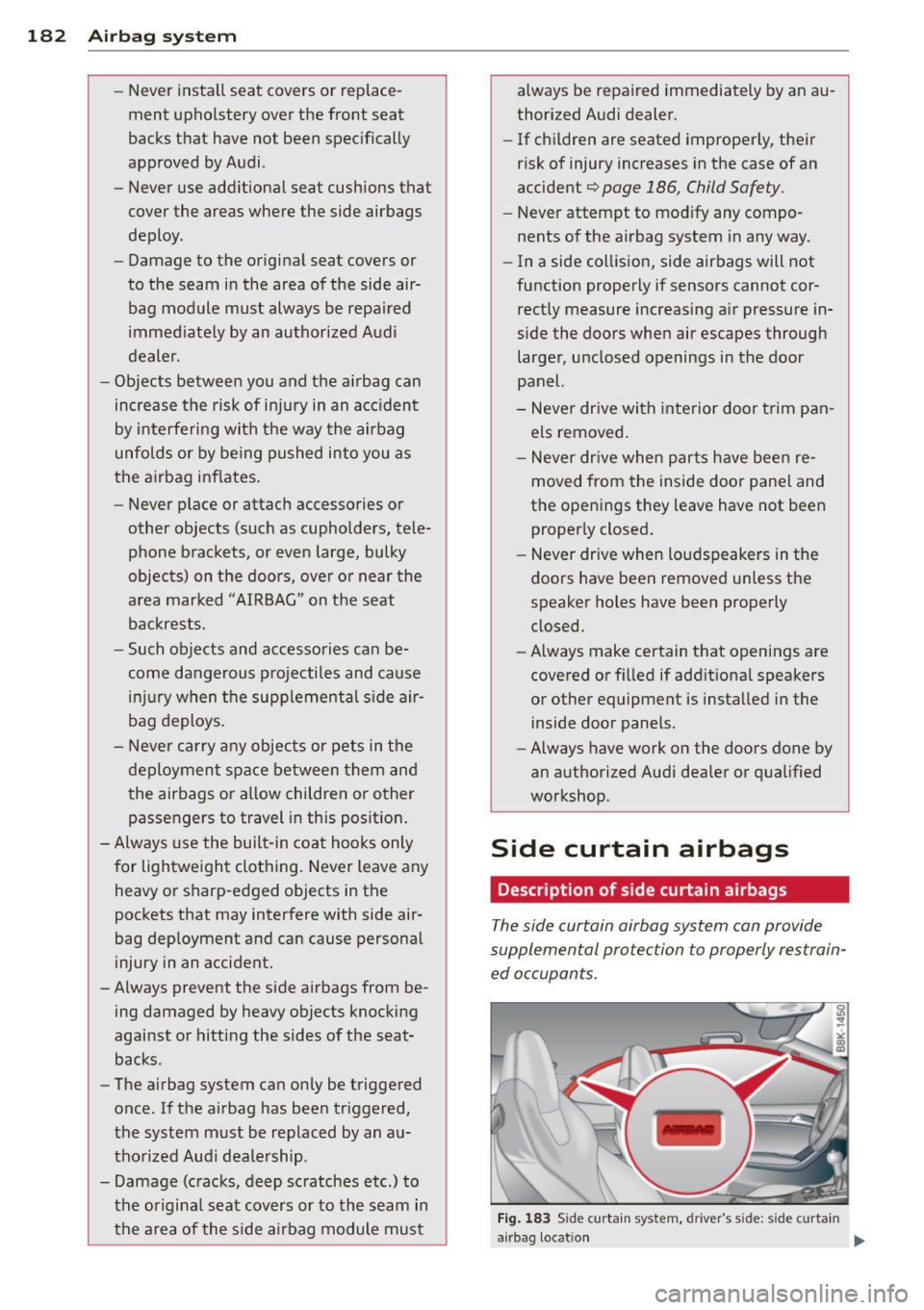
182 Airbag system
-Never insta ll seat covers or replace
ment upho lstery over the front seat
backs that have not been specifically
approved by Audi.
- Never use add itional seat cushions that
cover the areas where the side airbags
deploy .
- Damage to the original seat covers or
to the seam in the area of the side air
bag module must always be repa ired
immed iately by an authorized Audi
dealer .
- Objects between you and the airbag can
increase the risk of injury in an acc ident
by interfering with the way the airbag
unfolds or by being pushed into you as
the airbag inflates .
- Never place or attac h accessories or
other objects (such as cupholders, tele
phone b rackets, or even large, bulky
objects) on the doors, over o r near the
area marked "AIRBAG" on the seat backrests.
- Such objects and accessories can be
come dangerous p rojectiles and cause
i n ju ry when t he supplemental s ide air
bag deploys.
- Never ca rry any objects or pets in the
deployment space between them and
the airbags or a llow children or o ther
passengers to travel in th is posit ion .
- Always use the built-in coat hooks only
for lightwe igh t clothing . Never leave any
heavy or sharp -edged objects in the
pockets that may interfere with side air
bag dep loyment and can cause personal
injury in an accident.
- Always prevent the side a irbags from be
ing damaged by heavy objects knocki ng
against or hitting the sides of the seat
backs .
- The airbag system can only be triggered
once.
If the a irbag has been triggered,
the system m ust be replaced by an au
thorized Aud i deale rship.
- Damage (c rac ks, deep scratches etc.) to
the original seat covers or to the seam in
the area of the side airbag module must always be repa
ired immediately by an au
thorized Audi dealer.
- If children are seated improperly, their
risk of injury increases in the case of an
accident
c:> page 186, Child Safety.
- Never attempt to modify any compo
nents of the airbag system in any way.
- In a side collision, side airbags will not
function properly if sensors cannot cor
rectly measure increasing a ir pressure in
side the doo rs whe n air escapes through
large r, unclosed openings in the door
panel.
- Never dr ive with inte rior door trim pan
els removed.
- Never dr ive when par ts h ave bee n re
moved from the inside door pane l and
the openings they leave have not been proper ly closed .
- Never dr ive when loudspeakers in the
doors have been removed unless the
speaker holes have been properly
closed .
- Always make certain that openings are
covered or filled if add it iona l speakers
o r other equipment is installed in the
inside door panels .
- Always have work on the doors done by
an authorized Audi dea ler or q ualified
workshop .
Side curtain airbags
Description of side curtain airbags
The side curtain airbag system can provide
supplemental protection to properly restrain
ed occupants.
Fi g. 1 83 Side curta in system, driver 's s ide: side c urta in
a irbag loca tion
II>--
Page 185 of 316
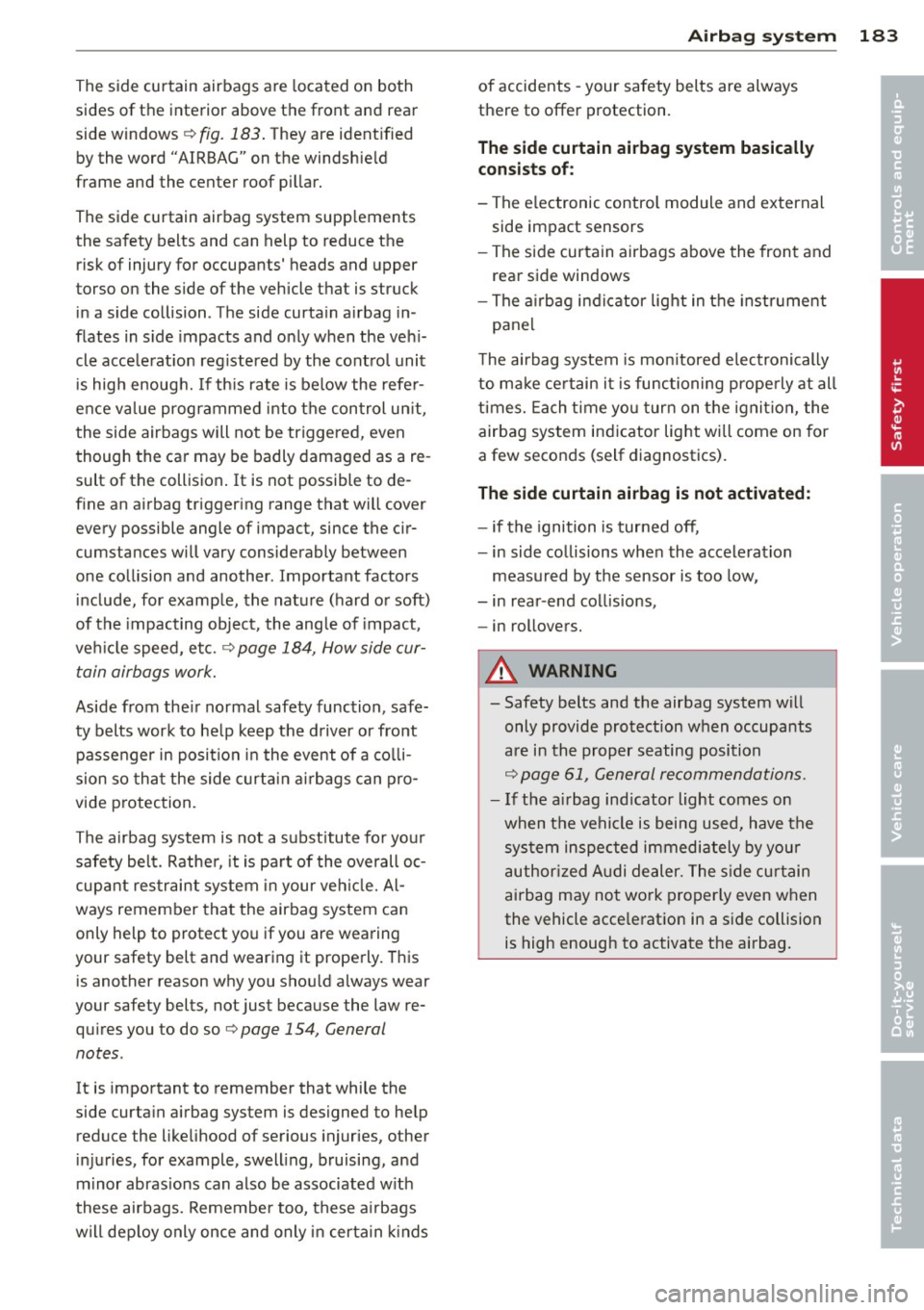
The side curtain airbags are located on both
sides of the interior above the front and rear
side windows ¢
fig. 183. They are ident ified
by the word "AIRBAG" on the windshie ld
frame and the center roof pillar.
The side curtain airbag system supp lements
the safety belts and can help to reduce the risk of inju ry for occupants ' heads and upper
t orso on the side of the vehicle that is struck
in a side collision . The side curta in a irbag in
flates in s ide impacts and only when the veh i
cle acce le rat ion reg istered by the contro l unit
i s high enoug h.
If th is rate is below the refer
ence va lue programmed into the control un it,
the side airbags will not be triggered, even
though the car may be badly damaged as a re
sult of the collision .
It is not possible to de
f ine an a irbag triggering range that will cover
every possible angle of impact, since the cir
cumstances will vary considerably between
one co llision and another . Important factors
in clude, for examp le, the nature (hard o r soft)
of the impacting object, the ang le of impact ,
ve hicl e speed, et c. ¢
page 184, How side cur
tain airbags work.
Aside from the ir normal safety function, safe
ty belts work to he lp keep the driver or front
passenger in posit ion i n the event of a co lli
sion so that the side curtai n ai rbags can pro
vide p rotection.
The airbag system is not a subst itute for your
safety belt. Rathe r, it is pa rt of the overall oc
cupa nt restraint system in your veh icle. Al
ways remember that the airbag system can
only help to protect you if you are wearing
your safety belt and wearing it properly. This
is another reason why you shou ld a lways wear
your safety belts, not just because the law re qu ires you to do so ¢
page 154, General
notes .
It is important to remember that while the
side curta in a irbag system is designed to he lp
reduce the likelihood of serious injuries, other
i njuries, for example, swelling, bruising, and
minor abrasions can also be associated w ith
these airbags. Remembe r too, these a irbags
will dep loy only once and only in certain kinds
A irbag system 183
of accidents -your safety belts are always
there to offer protection.
The side curtain airbag system basically
con sists of:
-The e lectronic control module and external
side impact sensors
- The side curtain airbags above the front and
rear side windows
- The a irbag in dic ator light in t he in str ument
panel
T he airbag system is mon itored e lectronically
to make ce rtain it is functioning prope rly at all
times. Each time yo u turn on the ignit ion, the
airbag system ind icator light will come on for
a few seconds (self diagnostics) .
The side curtain airbag is not activated :
-if the ignition is turned off ,
- in side collisions whe n the acceleration
measured by the sensor is too low,
- in rear-end collisions,
- in rollovers.
A WARNING
-Safety belts and the airbag system will
only provide protection when occupants
are in the proper seating position
¢ page 61, General recommendations .
-If the ai rbag ind icator light comes on
when t he vehicle is being used, have the
sys tem inspected immediately by your
author ized Audi dealer. The s ide cu rtain
airbag may not work proper ly even when
the vehicle acce leration in a side collision
is high enough to activate the airbag .
•
•
Page 189 of 316
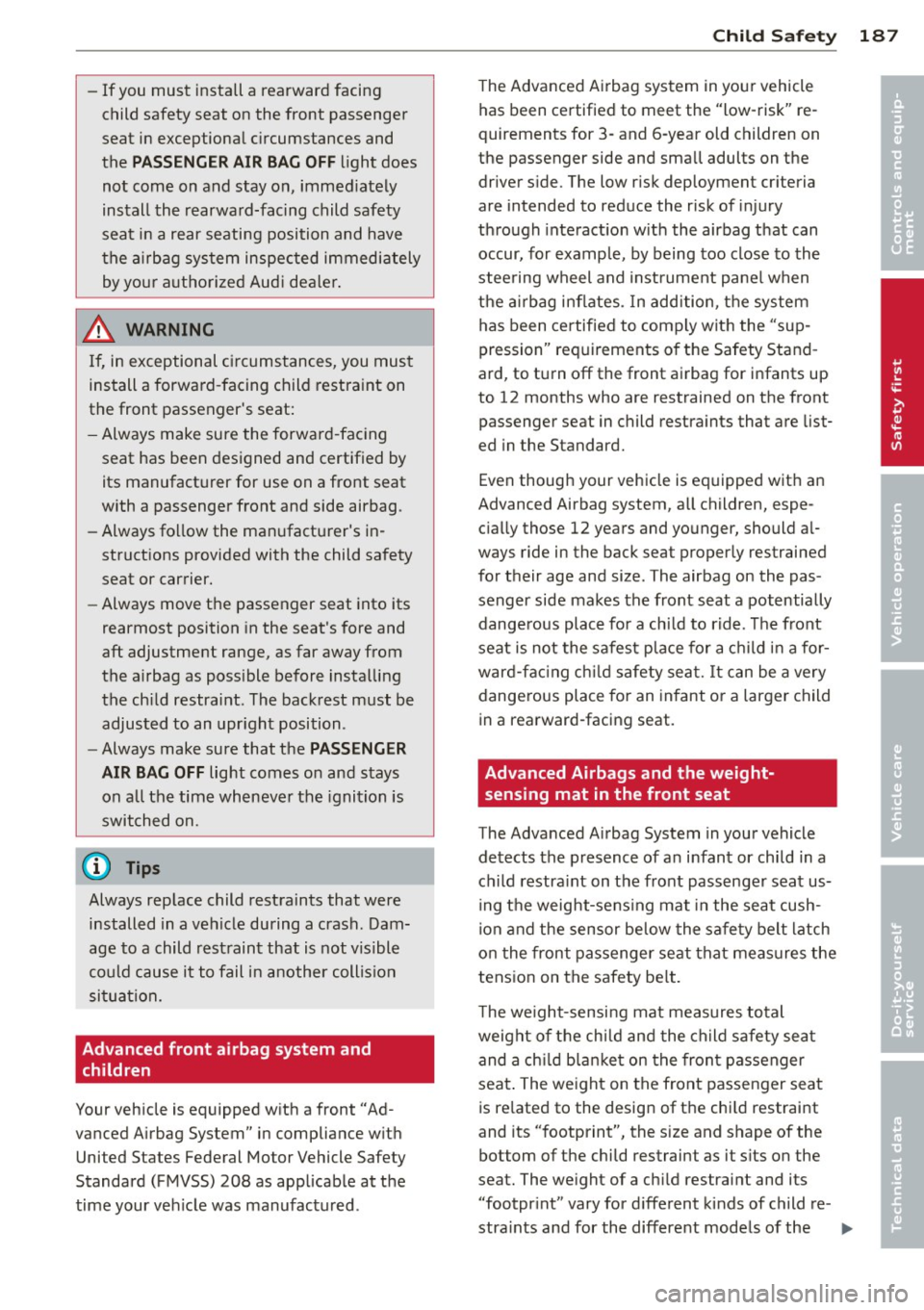
-If you must install a rearward facing
child safety seat on the front passenger
seat in exceptional circumstances and
the
PASSENGER AIR BAG OFF light does
not come on and stay on, immediately
install the rearward-facing child safety
seat in a rear seating position and have
the airbag system inspected immediately by your authorized Audi dealer.
,& WARNING
If, in exceptional circumstances, you must
install a forward-facing child restraint on
the front passenger's seat:
- Always make sure the forward-facing
seat has been designed and certified by
its manufacturer for use on a front seat
with a passenger front and side airbag.
- Always follow the manufacturer's in
structions provided with the child safety
seat or carrier.
- Always move the passenger seat into its
rearmost position in the seat's fore and
aft adjustment range, as far away from
the airbag as possible before installing
the child restraint. The backrest must be adjusted to an upright position .
- Always make sure that the
PASSENGER
AIR BAG OFF
light comes on and stays
on all the time whenever the ignition is
switched on.
@ Tips
Always replace child restraints that were
installed in a vehicle during a crash. Dam
age to a child restraint that is not visible
could cause it to fail in another collision
situation.
Advanced front airbag system and children
Your vehicle is equipped with a front "Ad
vanced Airbag System" in compliance with
United States Federal Motor Vehicle Safety
Standard (FMVSS) 208 as applicable at the
time your vehicle was manufactured .
Child Safety 187
The Advanced Airbag system in your vehicle
has been certified to meet the "low-risk" re
quirements for 3- and 6-year old children on
the passenger side and small adults on the driver side. The low risk deployment criteria
are intended to reduce the risk of injury
through interaction with the airbag that can
occur, for example, by being too close to the
steering wheel and instrument panel when
the airbag inflates. In addition, the system
has been certified to comply with the "sup
pression" requirements of the Safety Stand
ard, to turn off the front airbag for infants up
to 12 months who are restrained on the front passenger seat in child restraints that are list
ed in the Standard.
Even though your vehicle is equipped with an
Advanced Airbag system, all children, espe
cially those 12 years and younger, should al
ways ride in the back seat properly restrained
for their age and size . The airbag on the pas
senger side makes the front seat a potentially
dangerous place for a child to ride . The front
seat is not the safest place for a child in a for
ward-facing child safety seat. It can be a very
dangerous place for an infant or a larger child
in a rearward-facing seat.
Advanced Airbags and the weight
sensing mat in the front seat
The Advanced Airbag System in your vehicle
detects the presence of an infant or child in a
child restraint on the front passenger seat us
ing the weight-sensing mat in the seat cush
ion and the sensor below the safety belt latch
on the front passenger seat that measures the
tension on the safety belt.
The weight-sensing mat measures total
weight of the child and the child safety seat
and a child blanket on the front passenger
seat. The weight on the front passenger seat
is related to the design of the child restraint
and its "footprint", the size and shape of the
bottom of the child restraint as it sits on the
seat. The weight of a child restraint and its "footprint" vary for different kinds of child re -
straints and for the different models of the ..,. •
•
Page 190 of 316
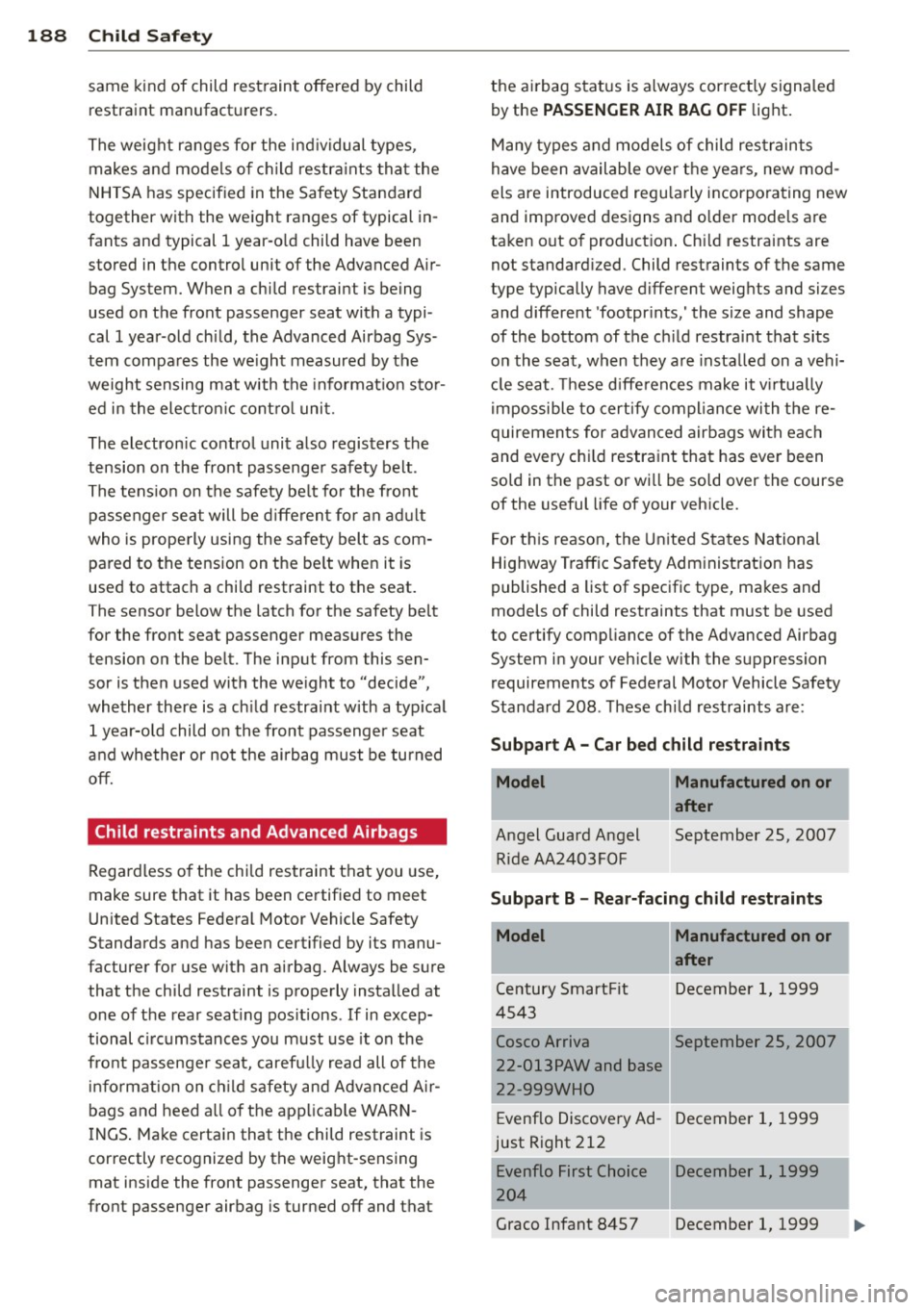
188 Child Saf ety
same kind of child rest raint offered by child
restraint manufact urers.
The weight ranges fo r the ind ividual types,
makes and mode ls o f chi ld restra ints that the
NHTSA has specified in the Safety Standard
together with the weight ranges of typical in
fants and typical 1 year-o ld child have been
stored in the control unit of the Advanced A ir
bag System. When a child restraint is being
used on the front passenger seat with a typi
cal 1 year-old ch ild, the Advanced Airbag Sys
tem compa res the we ight measured by the
weight sensing mat with the informat io n sto r
ed i n the ele ct ron ic cont ro l uni t.
The electron ic control unit also registers the
tension on the front passenge r safety belt .
The tens io n on the safety be lt fo r the front
passenger seat will be d iffe ren t for an ad ult
who is prope rly using the safety belt as com
pared to the tension on the be lt whe n it is
used to attach a chi ld restraint to the seat.
The sensor below the latch for the safety be lt
for the front seat passenger meas ures the
tension on the be lt. The input from this sen
sor is then used with the we ight to "decide",
whether there is a ch ild restraint w ith a typ ical
1 year-o ld child o n the front passenger seat
and whe ther or not the ai rbag must be tu rned
off.
Child restraints and Advanced Airbags
Regardless o f the child restraint t hat you use,
make sure that it has been ce rtified to meet
United States Federal Motor Vehicle Safety
Standards and has been certified by its manu
facturer for use with a n airbag. Always be sure
that the child restraint is properly instal led at
one of the rear seat ing pos itions .
If in excep
tional c ircumstances you must use it on the
fro nt passenger sea t, caref ully read all of the
i n format ion on c hild safety and Advanced A ir
bags and heed a ll of the app licab le WAR N
I NGS . Ma ke certain that the child restraint is
correctly recognized by the weig ht-sensing
mat inside the front passenger seat, that the
fro nt passenger airbag is turned off and that the a
irbag sta tus is always cor rect ly signa led
by the
PASSENGER AIR BAG OFF light .
Many types and models of child res traints
h ave been available over the yea rs, new mod
els are introduced regu larly incorporating new
and improved designs and o lde r mode ls are
ta ken out o f product ion . Ch ild restra ints are
not standard ized . Child restraints of the same
type typically have different weights and sizes
and different 'footpr ints,' the size and shape
of the bottom of the ch ild restra int that sits
on the seat, when they are insta lled on a vehi
cl e seat. These d iffe rences make it v irtually
i mpossible to certify compl ian ce wi th t he re
quiremen ts for advanced airbags with eac h
and every chi ld restraint that has eve r been
sold in the past or wi ll be sold over the course
of the useful life of your veh icle.
F or t his reason, the United S tates National
Highway T raffic Safety Adm inist ration has
published a list of specific type, ma kes and
models of child restraints that must be used
to certify comp liance of the Advanced Airbag
System i n your veh icle with the suppression
requirements of Federal Motor Vehicle Safety
Standa rd 208. These ch ild restraints a re:
Subpart A -Car bed child re straints
Model
A ngel Guard Angel
Ride AA2403FOF
Manufactured on or
after
September 25, 2007
Subpart B -Rear-facing child restraints
Model Manufactured on or
after
Ce ntury 5martFit December 1, 19 99
4 543
Cosco Arriva September 25, 2007
I
22-013PAW and base
22-999WHO
I
Evenflo Discove ry Ad- December 1, 1999
just Right 212
Evenflo First Choice December 1, 1999
20 4
Graco Infant 8457 December 1, 1999
Page 206 of 316
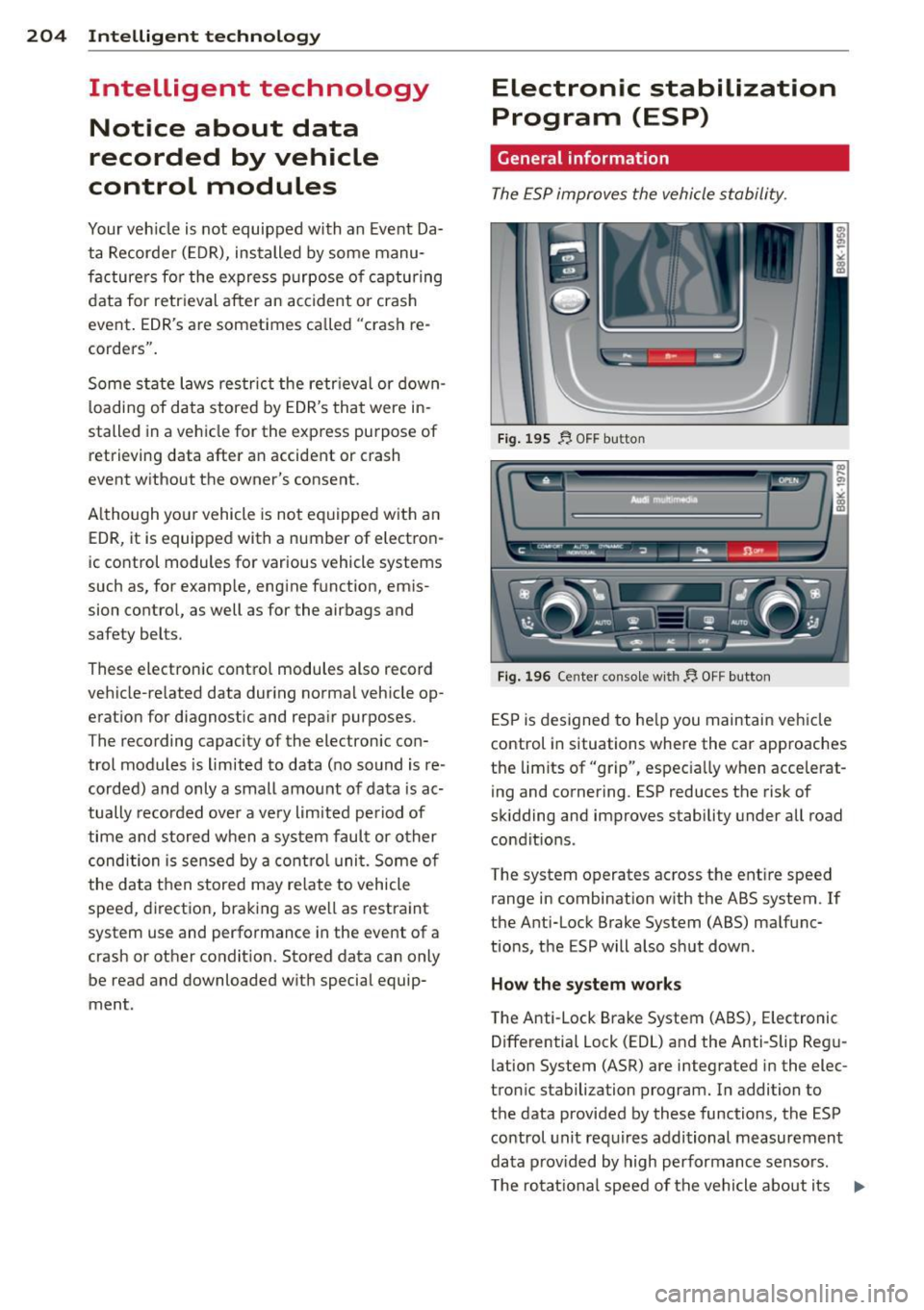
204 Intelligent technology
Intelligent technology
Notice about data
recorded by vehicle
control modules
Your veh icle is not equipped with an Event Da
ta Recorder (EDR), installed by some manu
facturers fo r the express purpose of capturing
data for retrieval after an accident or crash
event. EDR's are sometimes called "crash re
corders".
Some state laws restrict the retrieval or down
loading of data stored by EDR's that were in
stalled in a vehicle for the express purpose of retrieving data after an accident or crash
event without the owner's consent.
Although your vehicle is not equipped with an
EDR, it is equipped with a number of electron
ic control modules for various vehicle systems
such as, for example, engine function, emis
sion control, as well as for the airbags and
safety belts .
These electronic control modules also record
vehicle-related data during normal vehicle op
eration for diagnostic and repair purposes .
The recording capacity of the electronic con
trol modules is limited to data (no sound is re
corded) and only a small amount of data is ac
tually recorded over a very limited pe riod of
time and stored when a system fault or other condition is sensed by a control unit. Some of
the data then stored may relate to vehicle
speed, direction, braking as we ll as restraint
system use and performance in the event of a
crash or other condition. Stored data can only be read and downloaded with special equip
ment .
Electronic stabilization
Program (ESP)
General information
The ESP improves the vehicle stability .
Fig. 195 f;. OFF button
Fig. 196 Center console wit h ~ OFF button
ESP is designed to help you maintain vehicle
control in situations where the car approaches
the limits of "grip", especia lly when accelerat
ing and cornering . ESP reduces the risk of
skidding and improves stability under all road
conditions .
The system operates across the ent ire speed
range in combination with the ABS system . If
the Anti-Lock Brake System (ABS) malfunc
tions, the ESP will also shut down.
How the system works
The Anti -Lock Brake System (ABS), Electronic
Differential Lock (EDL) and the Anti-Slip Regu
lation System (ASR) are integrated in the elec
tronic stabilization program. In addition to
the data provided by these functions, the ESP
control unit requires additional measurement
data provided by high performance sensors.
T he rotational speed of the vehicle about its
II>-
Page 207 of 316
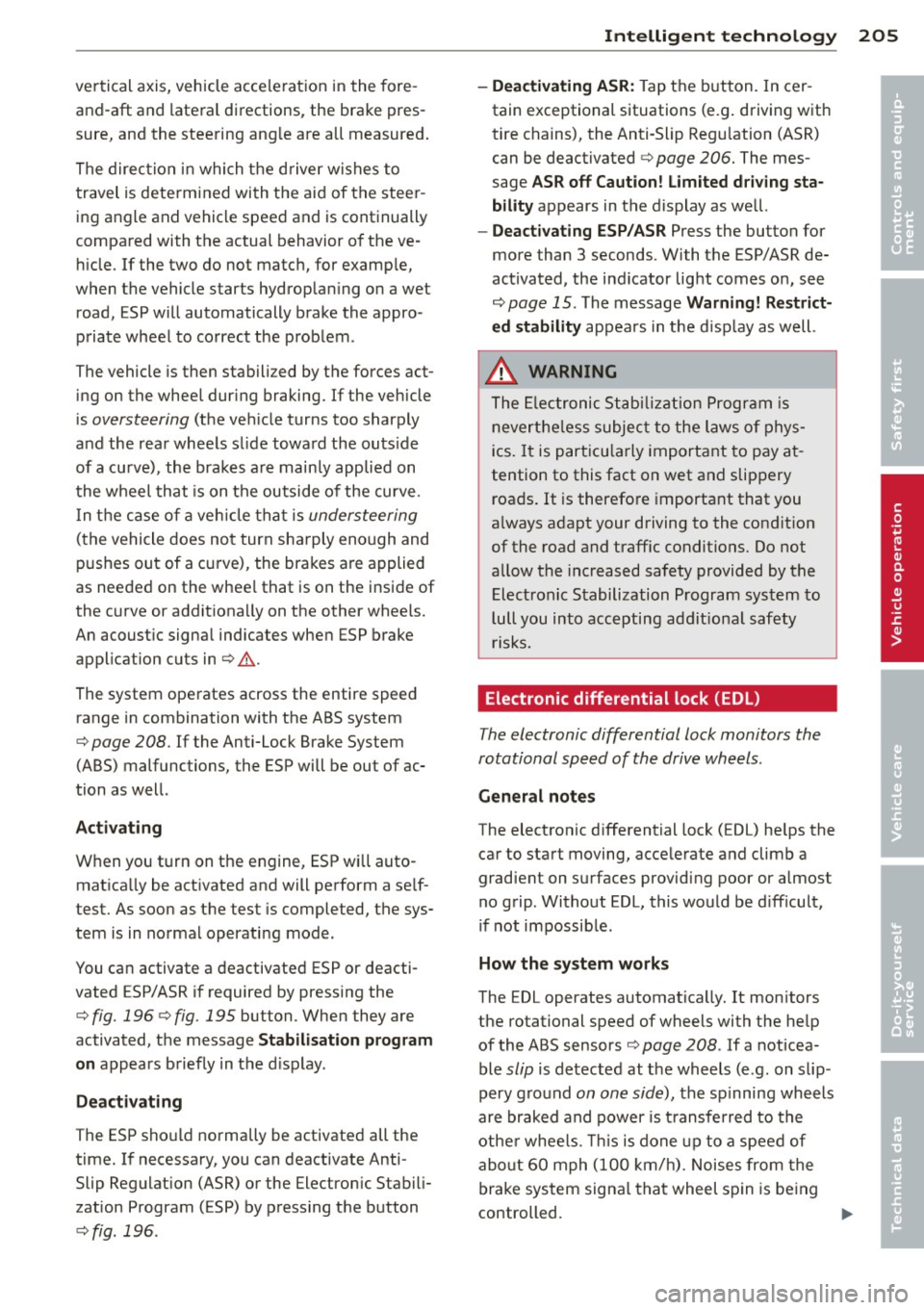
vertical axis, vehicle acceleration in the fore
and-aft and lateral directions , the brake pres
sure, and the steering ang le are all measured .
The direction in which the d river wishes to
travel is determined with the aid of the steer
ing angle and vehicle speed and is continually
compared with the actual behavior of the ve
h icle. If the two do not match, for examp le,
when the vehicle starts hydroplaning on a wet
road, ESP will automatically brake the appro
priate wheel to correct the problem.
The vehicle is then stabili zed by the forces act
ing on the wheel dur ing braking. If the vehicle
is
oversteering (the veh icle turns too sharply
and the rear wheels sl ide toward the outs ide
of a curve), the brakes are main ly applied on
the wheel that is on the outside of the curve.
I n the case of a ve hicle that is
understeering
(the vehicle does not turn sha rply enough and
pushes out of a curve) , the brakes are applied
as needed on the whee l that is on the inside of
the curve o r additiona lly on the other wheels.
An acoust ic signal indicates when ESP brake
application cuts in
q .& .
The system operates across the entire speed
range in combination with the ABS system
q page 208. If the Anti-Lock Brake System
(ABS) malfunctions, the ESP will be out of ac
tion as well.
Acti vating
When you turn on the engine, ESP wi ll auto
matica lly be activated and will perfo rm a se lf
test. As soon as the test is completed, the sys
tem is in normal operating mode .
You can activate a deactivated ESP or deacti
vated ESP/ASR if required by pressing the
qfig. 196 q fig . 195 button. When they are
activated, the message
Stabilisation prog ram
on
appears briefly in the d isplay.
D eacti vating
The ESP sho uld normally be activated all the
time. If necessary, you can deactivate Anti
Slip Regulation (ASR) or the Electron ic Stabili
zation Program (ESP) by pressing the button
<:::;, fig. 196 .
Intellig ent technolog y 205
-Dea cti vating ASR: Tap the b utton. In cer
tain exceptional situations (e.g . driving with
tire chains), the Anti -Slip Regu lation (ASR)
can be deactivated
q page 206. The mes
sage
ASR off Caution ! Limited d riv ing sta
bilit y
appears in the display as we ll.
- Deacti vating ESP /A SR Press the button for
more than 3 seconds. Wi th the ESP/ASR de
activated, the ind icator light comes on, see
c:::;, page 15 . The message War ning! R estrict
ed stability
appea rs in the d isp lay as well.
.8, WARNING -
The Electronic Stabi liz a tion Program is
neverthe less subjec t to the laws o f phys
ics. It is part icu la rly important to pay a t
tention to this fact on wet and slippery roads. It is therefo re important that you
a lways adapt your driving to the condit ion
of the road and traff ic conditions. Do not
allow the increased safety provided by the Elect ronic Stabilization Program system to
lull you into accepting addit iona l safety
r isks.
Electronic differential lock (EDL)
The electronic differential lock monitors the
rotational speed of the drive wheels .
General not es
The electronic d ifferential lock ( E0L) he lps the
car to star t moving, acce lerate and climb a
gradient on surfaces providing poor or almos t
no grip . Without EDL, this would be d iff icult,
if not impossible .
How the sy stem works
The EDL operates automatically. It mon itors
the rotational speed of wheels with the he lp
of the ABS sensors
q page 208 . If a noticea
ble
slip is detected at the wheels (e .g . on s lip
pery ground
on one side), the sp inning wheels
are braked and power is t ransferred to the
othe r whee ls. Thi s is done up to a speed of
abo ut 60 mph (100 km/h) . Noises from the
brake system signa l that wheel spin is be ing
controlled .
Ill>
•
•
Page 208 of 316
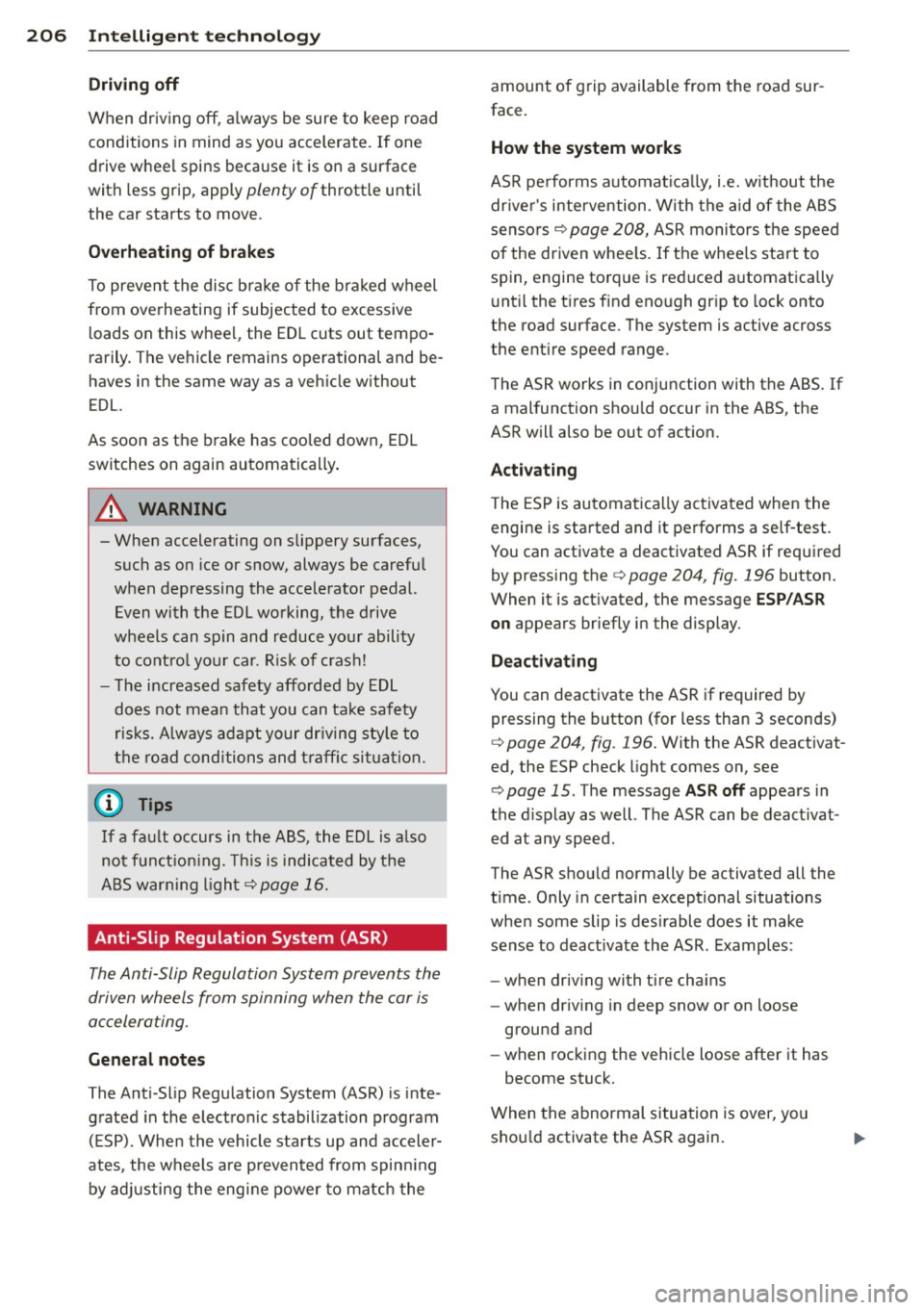
206 Intelligent technology
Driving off
When driving off, a lways be sure to keep road
conditions in mind as you accelerate. If one
drive wheel spins because it is on a surface
with less grip, apply
plenty of throttle until
the car starts to
move .
Overheating of brakes
To prevent the disc b rake o f the bra ked wheel
from overheating if subjected to excessive l oads on this whee l, the EDL cuts out tempo
rarily. The vehicle remains operational and be
haves in the same way as a vehicle without
EDL.
As soon as the brake has coo led down, EDL
switches on again automatically .
A WARNING
-When accelerating on slippery surfaces,
such as on ice or snow, always be careful
when depressing the accelerator pedal. Even with the EDL working, the drive
wheels can spin and reduce your ability
to control your car. Risk of crash!
- The increased safety afforded by EDL
does not mean that you can take safety
risks. Always adapt your dr iving style to
the road conditions and traffic situation.
0) Tips
If a fault occurs in the ABS, the EDL is also
not funct ion ing. Thi s is indicated by the
ABS war ning light ¢
page 16.
Anti-Slip Regulation System (ASR)
The Anti-Slip Regulation System prevents the
driven wheels from spinning when the car is
accelerating.
General notes
The Anti -Slip Regulation System (ASR) is inte
grated in the electronic stabilization program
( E SP). When the vehicle starts up and acceler
ates, the wheels are p revented from spinning
by adjusting the engine power to match the amount of grip available
from the road sur
face.
How the system works
ASR performs automat ically, i .e. w ithout the
driver's intervention. With the aid of the ABS
sensors ¢
page 208, ASR monitors the speed
of the driven whee ls. If the whee ls start to
spin, engine torque is reduced automatica lly
until the tires find enough grip to lock onto
the road surface. The system is active across
the entire speed range.
The ASR works in conjunction with the ABS . If
a malfunction should occur in the ABS, the
ASR will also be out of act ion.
Activating
T he ESP is automatica lly activated when the
engine is started and it performs a se lf-test .
You can activate a deactivated ASR if required by pressing the
¢ page 204, fig. 196 button.
When it is act ivated, the message
ESP/ASR
on
appears briefly in the display .
Deactivating
You can deactivate the ASR if required by
pressing the button (for less than 3 seconds)
¢
page 204, fig . 196. With the ASR deactivat
ed, the ESP check light comes on, see
¢
page 15 . The message ASR off appears in
the d isplay as well. The ASR can be deact ivat
ed at any speed.
The ASR s hould normally be activated all the
time . Only in certain exceptional situations
when some slip is desirable does it make
sense to deact ivate the ASR . Examples :
- when driving with tire cha ins
- when driving in deep snow or on loose
ground and
- when rocking the vehicle loose after it has
become stuck.
When the abnormal situation is
over, you
shou ld activate the ASR again .
Page 213 of 316
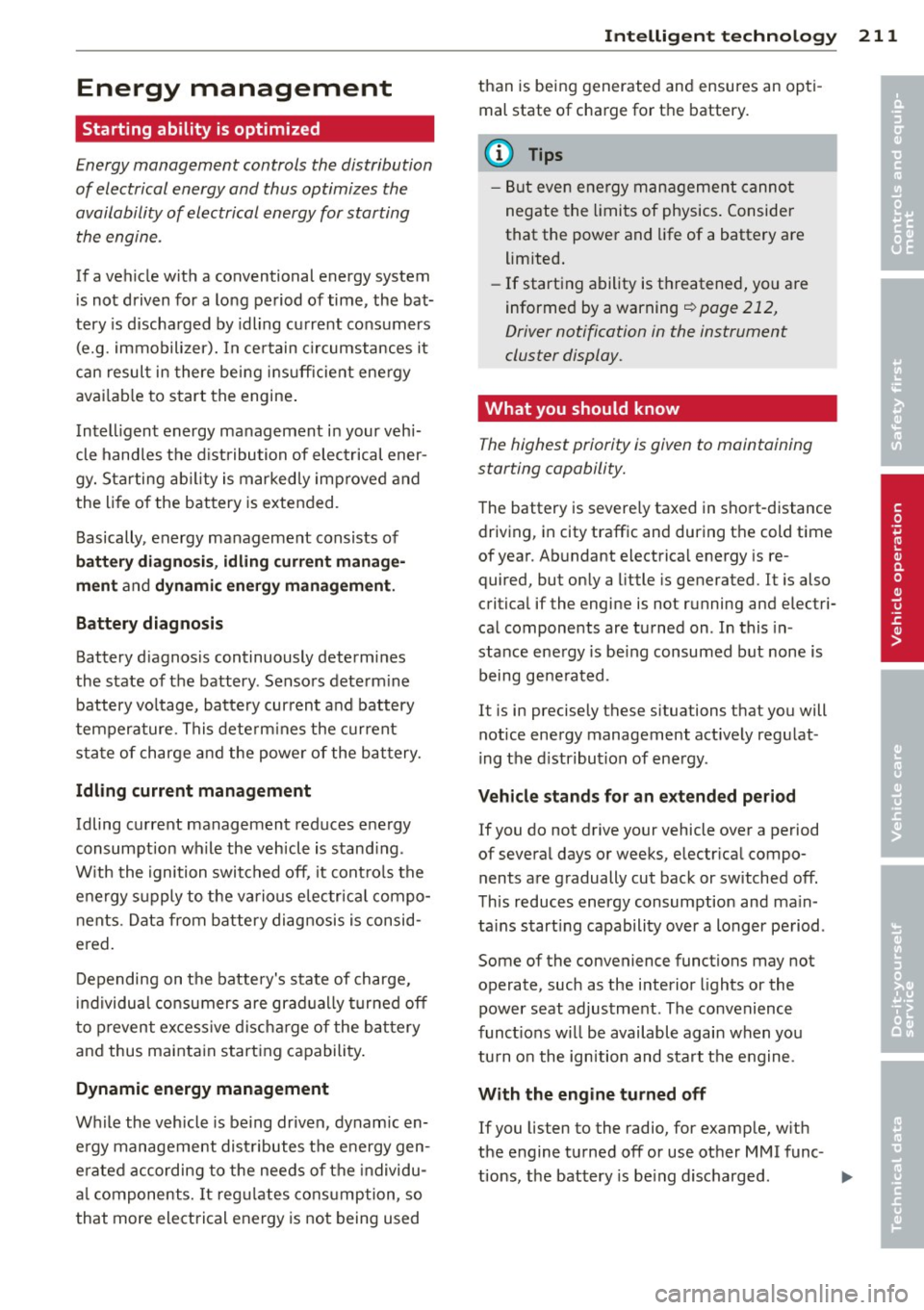
Energy management
Starting ability is optimized
Energy management controls the distribution
of electrical energy and thus optimizes the
availability of electrical energy for starting the engine .
If a vehicle with a conventional energy system
is not driven for a long period of time , the bat
tery is discharged by idling current consumers
(e.g. immobilizer). In ce rtain c ircumstances it
can result in there being insuff icient ene rgy
avai lab le to start the engine .
Intell igent energy management in your vehi
cle hand les the d istribution of electrical ener
gy. Starting ab il ity is markedly improved and
the life of the battery is extended.
Basically, energy management consists of
batt ery di ag nosis, idlin g current man ag e
m ent
and dyn ami c en ergy manage ment .
Batter y diagnosis
Battery diagnosis continuously determines
the state of the battery . Sensors determ ine
battery vo ltage, battery current and battery
temperature. This determ ines the current
state of charge and the powe r of the battery.
Idling curr ent man agement
Idling current management reduces ene rgy
consumption while the vehicle is stand ing .
W ith the ignition switched off, it cont ro ls the
energy supply to the va rious electr ical compo
nents . Data from battery diagnosis is consid
ered.
Depending on the battery's state of charge,
i nd ividua l consumers are gradual ly t urned off
to prevent excess ive d ischarge of the bat tery
and thus maintain starting capability .
Dynam ic en ergy management
While the vehicle is being driven, dynamic en
e rgy management dist ributes the energy gen
e rated according to the needs of the individu
a l components.
It reg ulates cons umption, so
that more electrical energy is not being used
Int ellig ent technolog y 211
than is being generated and ensures an opti
mal state of charge for the battery.
(0 Tips
- But even energy management canno t
negate the limits of physics . Consider
that the power and life of a battery are
limited .
- If starting ability is threatened, you are
informed by a warning
r:!) page 212,
Driver notification in the instrument
cluster display.
What you should know
The highest priority is given to maintaining
starting capability.
The battery is severe ly taxed in short -distance
driving, in city traffic and during the cold time
of year. Abundant electrical energy is re quired, but only a little is generated .
It is also
critical if the engine is not running and electri
cal components are turned on . In this in
stance energy is be ing consumed but none is
being generated.
It is in precisely these situations that you will
notice energy management actively regulat
ing the d istribution of energy .
Vehicle stands for an e xtended peri od
If you do not drive your vehicle over a period
of several days or weeks, e lectr ical compo
nents are gradually cut back or switched off.
This reduces energy consumption and ma in
ta ins start ing capability over a longer period .
Some of the convenience functions may not
operate, such as the interior lights or the power seat adjustment . The convenience
funct ions w ill be available again when you
tu rn o n the ign ition and start the engine.
With the eng ine tu rned off
If you listen to the radio, for examp le, w ith
the engine turned off or use other MMI func -
tions, the battery is be ing discharged.
IJJ,-
•
•